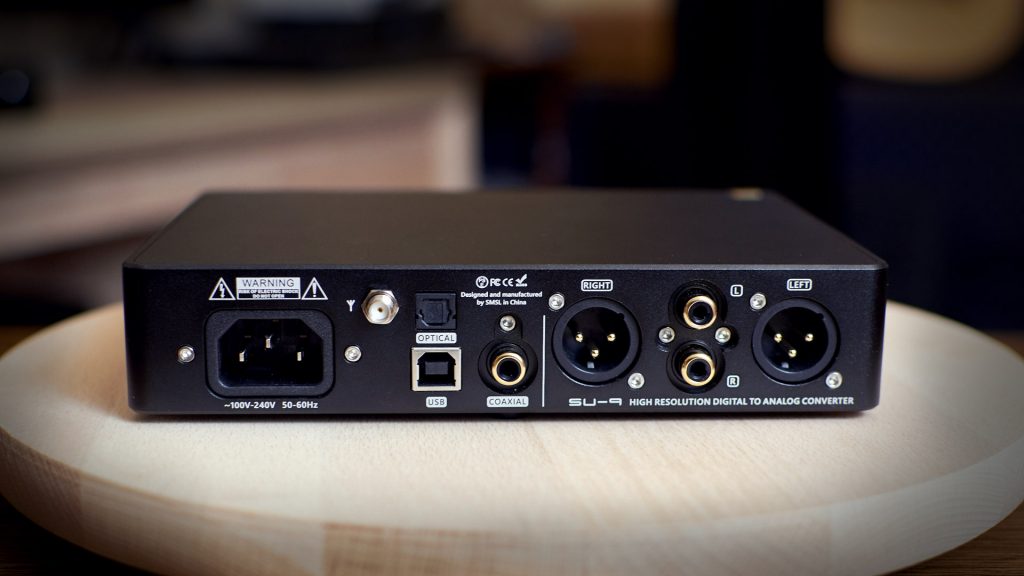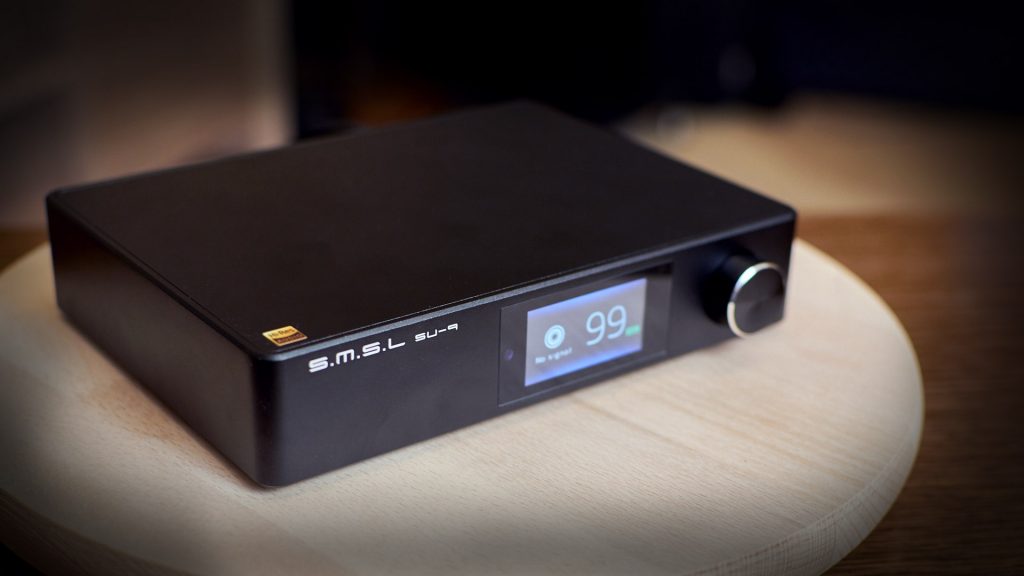SMSL SU-9 sits firmly in the middle of SMSL’s DAC offering with an asking price of $449. But where does this put SU-9 in terms of performance and features? Is it closer to the likes of budget Sanskrit 10th or flagship M400? Let’s try and find out.
Build and Connectivity
SU-9 features an all-metal build and a clean minimalistic design. But there’s nothing minimalistic about its connectivity capabilities. Aside from the usual digital inputs such as USB, optical, and coaxial, there’s also Bluetooth onboard. The good news continues with analog outs as we can choose between single-ended RCA and balanced XLR ones. Both of these can be used in a fixed or variable output level mode. Lastly, we see a big AC power connector, meaning that SU-9 is powered directly from the wall socket and it is in no need of an AC/DC adapter. This also means that the whole power-supply section is located inside the unit and upgrading this one with a linear power supply is not an option. On a positive note, SMSL claims the power supply to be an ultra-low noise one, so one less thing to think about.
There is no headphone-out to be found anywhere, meaning that SU-9 is a pure DAC meant to pair with an external amplifier, may it be one for speakers or headphones.

Features
In the front, we find one volume knob that doubles as a button. Every function and setting is accessible this way but provided remote control is sure a more convenient option. Big LCD unit provides you with easily readable information about inputs, volume, and type of files being played. Once you enter the settings, among other things you’ll find an option to dim the display, change digital filters, etc. But one that stands out is Sound color. Here you can choose between No filter, Rich, Tube, and Crystal, all coming in several varieties. On my end, I really liked the Rich option – it sounded rich in terms of timbre but without sacrificing details. That said, everybody should try these for themselves and find out if they like how they affect the sound.
Inside the unit, SMSL used ES9038PRO which is a flagship DAC chip from Sabre. Combined with a powerful XMOS receiver, it is capable of handling basically anything you can throw at it. The list includes PCM up to 768 kHz and DSD up to 512. Full hardware-based MQA unfolding is also onboard, so you’re all set and ready for every situation. For those of you yet not familiar with MQA, it’s basically an advanced compression algorithm used for Hi-Resolution streaming. It’s claimed to be the next big thing, but it is a lossy compression after all and I’m yet to hear it sounding as good as the regular uncompressed hi-resolution file. Anyhow, if you’re a Tidal streaming service user, that’s the only way to stream hi-res files, and with SU-9 you’ll be able to do that.
Sound
Once settled in my listening system, SU-9 proved to be a lively performer. The bassline is punchy and weighty. Tonally, it’s on the warmer side of things but fast and precise enough to follow a fast rhythm section when needed. Midbass is presented in the same fashion and lends some of its warmth to the midrange. Upper midrange, as well as highs, possesses commendable clarity. This type of voicing makes for an attractive mix of weighty, yet very resolving sound. Browsing through different filters and sound color options, you can lean the whole signature towards the slightly more analytical or slightly richer and tamer side of things. My personal Cyrus 8vs2 and KEF L50 combination, being on a somewhat leaner side of things, sounded the best with the Rich 1 filter engaged. This is something definitely worth playing with and finding the best combination according to your own and your system preferences.

Moving on to other traits, I struggle to remember any DAC at this price point being this dynamically expressive. Notes played through SMSL SU-9 strike fast and with intent, making for fun and engaging listening. When it comes to staging, we’re talking about focused and precise placement inside of a modestly sized soundstage. This DAC will not create some huge and airy presentation, but within its limits, it will separate and layer instruments and vocals neatly. After some fifty DACs I’ve tried so far, I came to expect this from a good Sabre-based device – it’s usually more about focus and precision than it is about sheer width and depth, and SU-9 is no exception.
Comparisons
SMSL Sanskrit 10th MKII is SMSL’s budget offering and one of my favorite entry-level DACs. It shares the same warmer sound signature with SU-9, as well as focus over width approach to sound-staging. However, SU-9 is clearly adding another layer of overall clarity and it’s resolving more subtle details. Dynamics are also stronger, making SU-9 a much livelier performer.
SMSL M400 is twice the price. It offers a somewhat wider soundstage and its tonality is slightly different with sweeter and more tame highs. Because of that, vocals sound very lush and seductive through M400, with SU-9 feeling slightly thinner in direct comparison. But in terms of resolving crisp edges and details, SU-9 holds its ground. In terms of dynamics too.
Schiit Modi Multibit can’t match the speed and energy of SU-9 but it can offer a warmer midbass and midrange, making for a fuller and lusher but somewhat hazier experience. Some will love that, but others will notice that Multibit’s bassline can’t kick as hard, and its highest spectrum can’t extend as high.
Denafrips Ares II is still my favorite DAC under one thousand dollars, offering unmatched soundstaging and natural tone timbre while matching other good qualities of SU-9. It also comes at a 70 percent price increase and with fewer features so I’d say they’re not a direct competition really. Each is a great device for what it is.
Conclusion
SMSL SU-9 is a clear step-up from SMSL’s budget offering in both features and sonic quality. I’ll even go as far as saying that it feels closer to the higher-end M400 than it is to its more affordable cousins. That makes it a great value and one of the finest midrange prepositions.
UPDATE: Few score points were knocked off since the initial review due to the arrival of new competitors such as SMSL M500 MKII.
| SMSL SU-9 – CHARACTERISTICS |
|
DAC chip: ES9038PRO |






Would you say this is less harsh or warmer? sound. I think I would like a warmer sound. I’m looking at this DAC the SU-9 and the SU-8S, DO200, LOXJIE D50, LOXJIE D40, M500 MK2, and the VMV D1SE or the SU-9N. I stream music with Tidal and never heard MQA but would like to have.
I have 3 Dac I can choose from the SU-9N for $340 and the SU-9 for $460 and the D1SE for $152 more then the SU-9